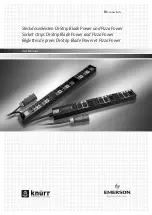
ProTechTPS Total Protection System
Manual 26710V1
70
Woodward
The use of the Speed Redundancy Manager allows users to elect to use three
speed sensing probes, or two speed sensing probes or only one speed sensing
probe in each modules’ overspeed logic depending on the specific application’s
requirements. If only two probes are used then the third module can be
configured to only use and vote on the shared speed signals (from the other
modules) to use in its overspeed and over-acceleration detection logic. Although
not recommended, if only one probe is used then the second and third modules
can be configured to only use and vote on the shared speed signal (from the first
module) to use in their overspeed and over-acceleration detection logic.
NOTE—If a speed probe is not connected to a ProTechTPS module the “Probe
type” setting must be set to “Not Used”.
If the module’s Speed Redundancy Manager is configured for use then each
module uses its local sensed speed signal and the shared speed signals from the
other two modules to select/vote the signal to use in its overspeed detection
logic. Each module’s Speed Redundancy manager can be configured as follows
depending on the number of used or healthy speed signals:
1. Three used/healthy speed signals condition (Base Function):
a. Median signal (middle signal)
b. Highest
signal
c. Lowest
signal
2. Two used/healthy speed signals condition (Fallback Function):
a. Highest
signal
b. Lowest
signal
3. One used/healthy speed signal condition (Two Inputs Failed Action):
a. Used/sensed healthy speed signal
b. Issue a trip command
In the Speed Redundancy Manager there is the Difference Alarm Limit and the
Difference Alarm Time. The Difference Alarm time is the time a difference is
allowed before an alarm is set.
When the Speed Redundancy Manager is used, losing one of the
speed signals will result in an alarm in all three modules. Once that
speed signal is fixed, all three modules will need to be reset to clear
the alarms (If the Reset inputs are shared, then one reset may reset
multiple modules).
Acceleration Redundancy Manager
The configuration/use of the Acceleration Redundancy Manager is not required.
If the ProTechTPS’s acceleration redundancy manager is not configured for use,
then each module simply uses its local speed sensor signal, and compares its
calculated acceleration rate to the modules’ over-acceleration setpoint to
determine an over-acceleration event.
If the ProTechTPS’s acceleration redundancy manager is configured for use then
each module uses its local calculated acceleration rate (calculated from the local
speed signal) and the shared acceleration rates from the other two modules to
select/vote the signal to use in its over-acceleration detection logic. The
acceleration redundancy manager can be configured to vote the median, highest
or lowest acceleration rate signal to use in its over-acceleration detection logic
and can be configured to change its voting logic based on the number of healthy
speed probes/signals.
Содержание ProTech TPS
Страница 36: ...ProTechTPS Total Protection System Manual 26710V1 34 Woodward Figure 2 7 Inside View of ProTechTPS ...
Страница 37: ...Manual 26710V1 ProTechTPS Total Protection System Woodward 35 Figure 2 8 ProTechTPS Control Wiring Diagram ...
Страница 62: ...ProTechTPS Total Protection System Manual 26710V1 60 Woodward Figure 3 8 Simplex Trip Block Assembly ...
Страница 63: ...Manual 26710V1 ProTechTPS Total Protection System Woodward 61 Figure 3 9 Dual Redundant Trip Block Assembly ...
Страница 74: ...ProTechTPS Total Protection System Manual 26710V1 72 Woodward Figure 3 14 Start Logic Diagram ...
Страница 122: ...ProTechTPS Total Protection System Manual 26710V1 120 Woodward Advanced Menu ...
Страница 124: ...ProTechTPS Total Protection System Manual 26710V1 122 Woodward Declarations ...
















































